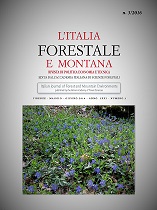Climate change and land suitability for Pinus nigra J.F. Arnold in Tuscany, Central Italy
Published 2016-08-10
Keywords
Copyright (c) 2016 Italian Journal of Forest and Mountain Environments

This work is licensed under a Creative Commons Attribution-NonCommercial 4.0 International License.
Abstract
In this study we assessed the land suitability for black pine forests (Pinus nigra J.F. Arnold) in Tuscany Region (Central Italy), and for the most frequent minor species in the pine stands – chestnut, turkey oak and beech - in a climate change scenario. The habitat suitability maps were constructed by the land suitability method of FAO using climatic parameters (temperature and precipitation) and physical parameters (slope of the land and soil characteristics). The climate change scenario used is the A2 scenario of HadCM3 model. The predictive ability of cartographic models was evaluated with ROC statistical analysis. The accuracy of the habitat suitability maps was good (AUC = 0.875 for chestnut, and 0.813 for black pine), especially for beech (AUC = 0.952); for the turkey oak, the quality of the cartographic model was lower (AUC = 0.628) than the other species. The results indicate the presence of critical environmental issues for about 20% of the total area of pine forests (10,071 ha), a proportion that rises to 50% in the climate change scenario considered. The models obtained for minor species indicate that turkey oak and chestnut could play a useful role in the future for the re-naturalization of black pine forests in the context of environmental changes.

